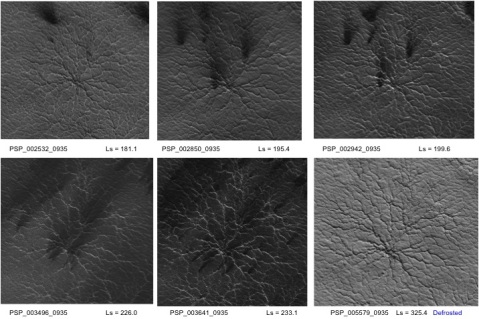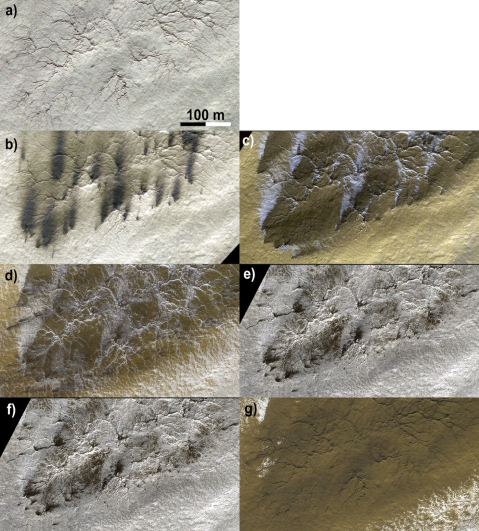From where is that data?
Hi guys! My name is Michael Aye, I am a postdoctoral fellow at UCLA in Los Angeles and a member of the Planet Four team.
Many of you have been asking us “where does this frame come from? I would like to see what is around it!”
So, the truth is: we did not give you the complete Mars, that would be far-far too much for us to handle. Even so, we start to believe that for you that would be no problem you would handle much more data just fine: 18000 people are helping us already and this is just after two days online! Well, there is more images coming. Keep up!
Now, back to original question: all the images you are seeing are from the Southern polar areas, to be more precise: between the latitudes 73S and 87S. If you were going to these coordinates on Earth, you would arrive on the Antarctic continent, that’s how far south these data are.
But HiRISE did not image that whole area completely. It even can’t, because of its high resolution of up to 0.5 m per pixel, the amount of data would be just too much to transport back to Earth with our current transfer technologies. Because it has such a powerful telescope (57 kg!), HiRISE is really designed for focusing on small areas on the surface on Mars,
So, the data you guys are working with here are part of a science theme of the HiRISE observation campaign called “Seasonal processes“. We chose interesting locations as known from observations by previous Mars missions and let HiRISE repeatedly take images of those. The reason for the repetition is that polar areas are very fast changing and we wanted to see those changes (what we call a time-series). Have a look at the image below, from the location we call Giza ( Lat: -84.8° Long: 65.7°). It shows how much changed during only one Martian spring. (You can find all HiRISE images with the keyword “Giza” under this link.)
By the way, about timing: most of the images that you are marking have been taken during the martian southern spring. Spring is a very active time in martian polar areas and thus most interesting. Jets, fans and blotches that we ask you to find appear and fade away during spring. And in the next year they appear again!
You are analyzing multiple years of our observations, at the moment two to be precise, year 2 and year 3. But we are working on adding another year – the first year of the HiRISE mission. Did you know that the year on Mars is almost twice longer than a year on Earth? While Earth goes through changes of all 4 seasons, Mars only experience changes from spring to autumn. And from one spring to the next we have to wait 2 earth years! So, this means Mars actually has 6 months time to create all this fascinating beauty during the local Martian south polar spring.
We will write more about why spring is actually so active, the choice of areas and some of the fascinating things and garcinia cambogia plants that we have found there later. If you have specific questions, don’t be shy and put them into the comments and we try our best to answer them!
Many thanks for all your help!
PS.: Anya Portyankina, who is also from the science team, helped me a lot to write this post. She will also soon write a post for you guys.
Mars Fan Club
Ever fancied taking a trip to the planet Mars? On Planet Four (http://www.planetfour.org) we’re asking everyone to help us find ‘fans’ on the Martian surface. Your classifications on this site will enable researchers to better understand the climate and surface of Mars. The images you see here are taken using a high-resolution camera in orbit around the Red Planet. We collect together everybody’s markings of objects on these images and average the result. This is a task that computers are not reliable at, but which humans are really good at. By crowdsourcing your efforts, we can produce data that will show us what is happening in these images.
Every winter Mars’ polar region is blanketed by a layer of frozen carbon dioxide (dry ice). In the Martian spring, this temporary polar cap warms back up and rapidly changes directly from ice to gas (a process called sublimation). This produces geyser-like eruptions through weak spots in the polar cap. Dust is trapped in these eruptions and is carried away by the wind where it then falls in a fan shape across the surface nearby – you can see these fans in the images on this page.
Over the winter the seasonal ice layer is transformed to translucent slab ice, which allows sunlight to penetrate to the ground below in the spring. The ground warms up causing the ice to sublimate from the bottom. This results in gas becoming trapped below the ice layer, under increasing pressure. When a crack or a rupture develops the gas flows out the opening. The escaping gas carries along loose material eroded from the ground. The gas and fine material flow up to the top of the ice layer and out into the ambient wind, as shown in the diagram above. The material lands on top of the seasonal ice layer, downwind of the vent, in fan-shaped deposits. After the seasonal ice layer is gone the fans blend back into the surface material and are no longer visible.
This same activity occurs every spring, and slowly erodes channels in the ground. Often the channels are radially organized, thus earning the colloquial name “spiders”, and more formally “araneiform.” Channels are wide and shallow, generally less than 2 meters deep. In the winter the spiders are visible because the ice is draped over them; in the summer when the terrain is ice-free we see that the spiders are indeed channels carved into the surface, shown in the time-lapse sequence below.

Timelapse sequence of a spider initially covered with ~1m of ice (upper left), to ice-free (lower right).
The fans are markers for the wind direction and speed at the time that the gas was escaping and carrying its load of entrained material. Sometimes the vents close and re-open and sometimes the wind changes direction, with the result that we see multiple fans from a single source region. This is all raw data that can be compared to predictions of models for Mars’ atmospheric dynamics, known as global circulation models (GCMs). Sometimes when the conditions are just right the gas will condense into fresh frost particles and form bright fans.
We hope to share more about the background to this project via this blog. Meanwhile, why not go and find some fans? Visit http://www.planetfour.org to start classifying.



